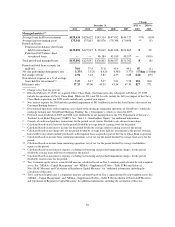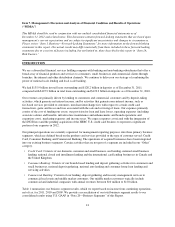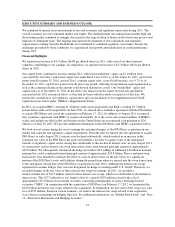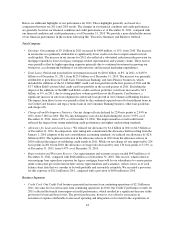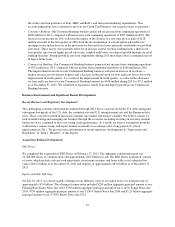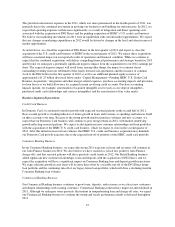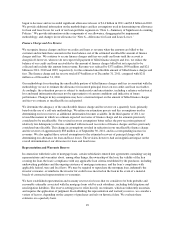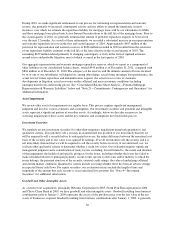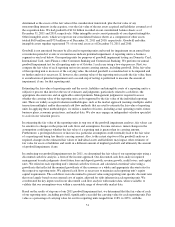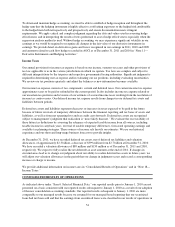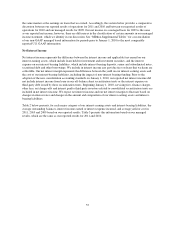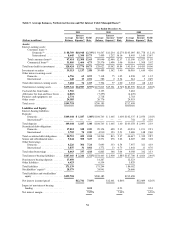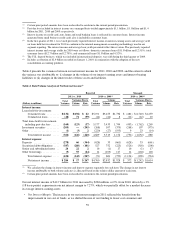Capital One 2011 Annual Report Download - page 69
Download and view the complete annual report
Please find page 69 of the 2011 Capital One annual report below. You can navigate through the pages in the report by either clicking on the pages listed below, or by using the keyword search tool below to find specific information within the annual report.began to decrease and we recorded significant allowance releases of $1.4 billion in 2011 and $2.8 billion in 2010.
We provide additional information on the methodologies and key assumptions used in determining our allowance
for loan and lease losses for each of our loan portfolio segments in “Note 1—Summary of Significant Accounting
Policies.” We provide information on the components of our allowance, disaggregated by impairment
methodology, and changes in our allowance in “Note 6—Allowance for Loan and Lease Losses.”
Finance Charge and Fee Reserve
We recognize finance charges and fees on credit card loans as revenue when the amounts are billed to the
customer and include these amounts in the loan balance, net of the estimated uncollectible amount of finance
charges and fees. We continue to accrue finance charges and fees on credit card loans until the account is
charged-off; however, when we do not expect full payment of billed finance charges and fees, we reduce the
balance of our credit card loan receivables by the amount of finance charges billed but not expected to be
collected and exclude this amount from revenue. Revenue was reduced by $371 million, $950 million and $2.1
billion in 2011, 2010 and 2009, respectively, for the estimated uncollectible amount of billed finance charges and
fees. The finance charge and fee reserve totaled $74 million as of December 31, 2011, compared with $211
million as of December 31, 2010.
Our methodology for estimating the uncollectible portion of billed finance charges and fees is consistent with the
methodology we use to estimate the allowance for incurred principal losses on our credit card loan receivables.
Accordingly, the estimation process is subject to similar risks and uncertainties, including a reliance on historical
loss and trend information that may not be representative of current conditions and indicative of future
performance. Changes in key assumptions may have a material impact on the amount of billed finance charges
and fees we estimate as uncollectible in each period.
We determine the adequacy of the uncollectible finance charge and fee reserve on a quarterly basis, primarily
based on the use of a roll-rate methodology. We refine our estimation process and key assumptions used in
determining our loss reserves as additional information becomes available. In the third quarter of 2011, we
revised the manner in which we estimate expected recoveries of finance charge and fee amounts previously
considered to be uncollectible. Our revised recovery assumptions better reflect the post-recession pattern of
relatively low delinquency roll-rates combined with increased recoveries of finance charges and fees previously
considered uncollectible. This change in assumptions resulted in reduction in our uncollectible finance charge
and fee reserves of approximately $83 million as of September 30, 2011, and in a corresponding increase in
revenues. We also applied these revised assumptions to the estimated recovery of principal charge-offs in
determining our allowance for loan and lease losses. The revision, however, had an insignificant impact on the
overall determination of our allowance for lease and loan losses.
Representation and Warranty Reserve
In connection with their sales of mortgage loans, certain subsidiaries entered into agreements containing varying
representations and warranties about, among other things, the ownership of the loan, the validity of the lien
securing the loan, the loan’s compliance with any applicable loan criteria established by the purchaser, including
underwriting guidelines and the ongoing existence of mortgage insurance, and the loan’s compliance with
applicable federal, state and local laws. We may be required to repurchase the mortgage loan, indemnify the
investor or insurer, or reimburse the investor for credit losses incurred on the loan in the event of a material
breach of contractual representations or warranties.
We have established representation and warranty reserves for losses that we consider to be both probable and
reasonably estimable associated with the mortgage loans sold by each subsidiary, including both litigation and
non-litigation liabilities. The reserve-setting process relies heavily on estimates, which are inherently uncertain,
and requires the application of judgment. In establishing the representation and warranty reserves, we consider a
variety of factors, depending on the category of purchaser and rely on historical data. We evaluate these
estimates on a quarterly basis.
49


